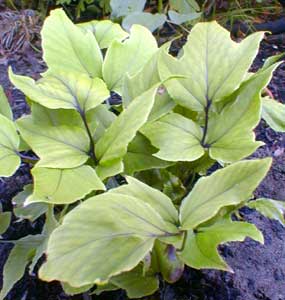
Fishtail Holly Fern; or,
Dwarf Netvein Holly Fern
"Degged with dew, dappled with dew
Are the groins of the braes that the brook treads through,
Wiry heathpacks, flitches of fern,
And the beadbonny ash that sits over the burn."
-Gerard Manley Hopkins
(1844-1889)
(1844-1889)
Cyrtomium caryotideum is a very widespread holly fern, native of Southeast Asia, China, northern India, & islands of South Pacific. As a popular garden fern in temperate to subtropical gardens, & maritime to alpine gardens, it has been busily extending its range, being now naturalized in Louisiana & evidently getting established in Mississippi, Georgia & Oregon, as well as in other countries round the world.
The nursery trade seems to have settled on Fishtail Holly Fern as the most used common name, on the premise that the three-pronged leaf-ends look like the tails of fishes. The older common name Net-vein or Netvein Holly Fern is likewise apropos, the gorgeous light green leaves having an impressive purplish veining.
It is also called Dwarf Holly Fern because it is usually only one foot tall, & even though it conceivably reaches two feet tall, that is still smaller than most of the gardened Cyrtomiums (i.e., C. falcatum).
Ferns of this genus are collectively called Holly Ferns because the stiff evergreen leaves so much resemble holly. Over time it can spread by rhizomes to three feet or wider, & will likely need to be dug up & divided every few years.
Highly adaptable for zones 6 through 9, Netvein Holly Fern does well in part sun or part shade, tolerating more sunlight & droughtiness than most ferns (though preferring perpetually moist soil with good drainage in partial shade), making it a good choice for containers, rock gardens, or rocky ground, where not many ferns would do as well.
We planted one in the raised patio garden, because that garden has a great many die-back perennials, & needed a few things with a winter presence.